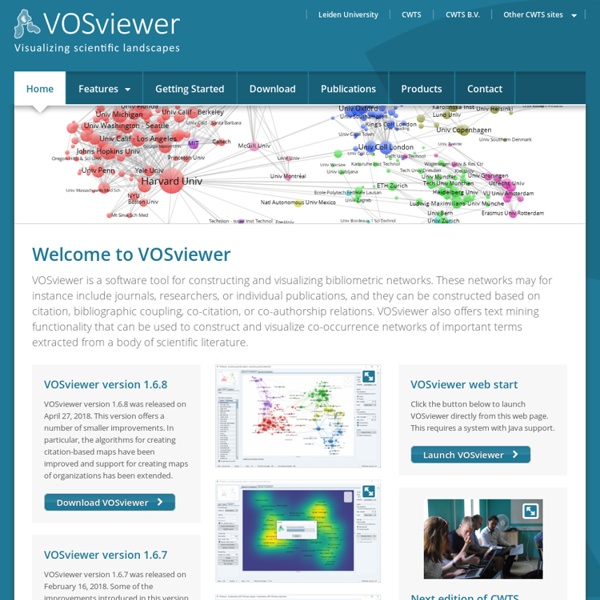



Jack Hagley is a London based Graphic Designer specialising in... - Jack Hagley // Graphic Design // Infographics Jack Hagley is a London based Graphic Designer specialising in Infographics Specialist in infographic design and data visualisation. I also do iconography, illustration, branding, art direction and various other graphic design projects. Tell me about your project My work has been in The Times, the Guardian and Wired and I've been lucky enough to work under David McCandless at Information is Beautiful. Loves: Challenges, clarity, learning, deadlines. Get the most up-to-date version of my Infographic CV here. No Flash. PinterestTumblrTwitterExperimental Stuff
Cytoscape: An Open Source Platform for Complex Network Analysis and Visualization How to Develop Rockstar B2B Buyer Personas - Referral SaaSquatch Learning to develop b2b buyer personas is essential to building a modern marketing organization. When implemented properly these buyer personas create stronger alignment across your different departments. When developing a buyer persona some of the common traits are appearance, personality, their story, their needs, and their values. The idea behind the strategy is that once you’ve better defined your ideal customer you can better market to and sell to them. In my opinion it’s a must for any B2B business. Want our Buyer Persona Checklist? Here’s one example of a b2b buyer persona – Image Source The chart below shows us the effects of creating B2B personas had on an IT company called Skytap. Image Source One of the problems is that typically B2B personas aren’t created properly or used correctly within an organization and this wastes time and money. The main problem is that developing a persona for a B2B customer is considerably different than developing a persona for a B2C. 1. Image source
38 Tools For Beautiful Data Visualisations | DBi As we enter the Big Data era, it becomes more important to properly expand our capacity to process information for analysis and communication purposes. In a business context, this is evident as good visualisation techniques can support statistical treatment of data, or even become an analysis technique. But also, can be used as a communication tool to report insights that inform decisions. Today there are plenty of tools out there that can be used to improve your data visualisation efforts at every level. Javascript Libraries Circular Hierarchy – D3.js Python Libraries Kartograph.py – Mapsigraph – Node-link, treesMatplotlib – Most types of statistical plotsPycha – Pie chart, bar chart, area chartNetworkX – Node-link Java / PHP Prefuse – Area chart, Time series, node-link, tree, timeline, steam graph, radial hierarchyJpGraph – Line plot, scatter plot, bar chart, bubble chart, contours chart, field chart, splines, pie chart, boxplot, polar plot, radial chart, maps Web Applications
Orange – Data Mining Fruitful & Fun Here Are 10 Buyer Persona Examples to Help You Create Your Own 5 minute read In a recent post, we looked at how you can create a buyer persona to help you get to know your audience, improve your marketing strategies, and create better content. We also offered a PDF buyer persona template you could use to develop your ideal customer profile. Now, we are going to dive deeper into that topic and look at specific buyer persona examples that other companies have created. By looking at what other businesses use, you can decide which format might be best for you and your company. You can see which information you may want to add or reorganize to build a more useful buyer persona. While the basics of most buyer persona examples will be the same, there are small differences that can make a big impact. B2C Buyer Persona Examples Let’s start by looking at a few B2C or business-to-customer buyer persona examples. In the first of our buyer persona examples, you can see that a persona doesn’t necessarily need to be long in length to strongly convey a message.
Growing importance of content discovery platforms for publishers | Media Network - Outbrain partner zone | Guardian Professional Stephanie Himoff: "Content discovery is continuing to grow in importance and it’s fantastic to be able to work with Guardian News & Media." Photograph: Eric Savage/Getty Images Guardian News & Media has partnered with leading content discovery platform Outbrain to increase user engagement across its site, via smart personalised recommendations on editorial content. Guardian News & Media will work with Outbrain, using its complete solution for content recommendation across text articles. Tim Gentry at Guardian News & Media said: "We are constantly looking for new ways to showcase our award-winning journalism and keep our ever-increasing audiences interested, engaged and active with relevant content across our digital platforms. Stephanie Himoff, Outbrain's UK Managing Director said: "The Guardian is one of the most innovative and forward thinking publishers in the world. Copy on this page is provided by Outbrain, supporter of the digital content hub
Protovis Protovis composes custom views of data with simple marks such as bars and dots. Unlike low-level graphics libraries that quickly become tedious for visualization, Protovis defines marks through dynamic properties that encode data, allowing inheritance, scales and layouts to simplify construction. Protovis is free and open-source, provided under the BSD License. It uses JavaScript and SVG for web-native visualizations; no plugin required (though you will need a modern web browser)! Although programming experience is helpful, Protovis is mostly declarative and designed to be learned by example. Protovis is no longer under active development.The final release of Protovis was v3.3.1 (4.7 MB). This project was led by Mike Bostock and Jeff Heer of the Stanford Visualization Group, with significant help from Vadim Ogievetsky. Updates June 28, 2011 - Protovis is no longer under active development. September 17, 2010 - Release 3.3 is available on GitHub. May 28, 2010 - ZOMG! Getting Started